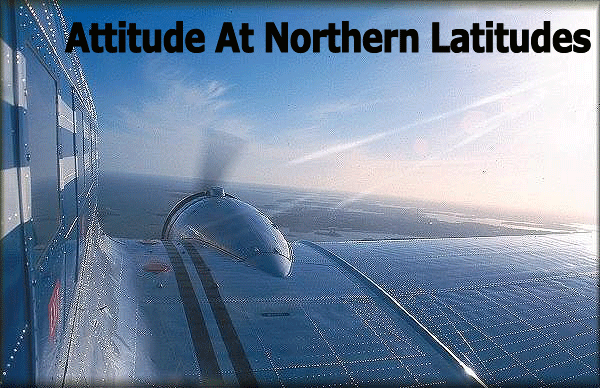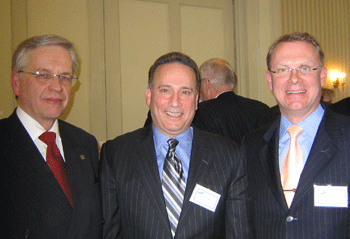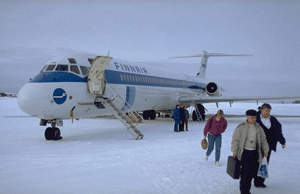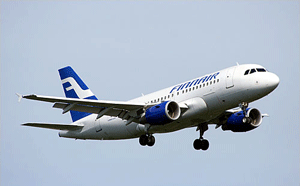
Despite change, tradition rules at Finnair. Here is an unusual
photograph taken by Janne Laukkonen of the beautifully restored
Aero (Finnair) Douglas DC-3 in flight.
|
Jukka Heinonen, President
and CEO of Finnair has a ready answer for just about anything as this
recently appointed airline chief forges forward in 2006 in command of
the northern Europe airline that has once again delivered solid financial
results while placing record orders for new aircraft and expanding to
new destinations, especially in Asia.
But his favorite answer is to the almost
age old question of whether and when AY might ever merge or be taken over
by another carrier or even nearby rival SAS.
“Finnair is 57% owned by the Finnish
government and indication amongst most people in Finland is that our carrier
should remain independent rather than in one scenario becoming a small
part of a bigger airline that would in fact just gobble us up.
"But still some wonder if Finnair will
be able to continue as an independent airline in the new world competition
for airlines besieged by high fuel costs and over-capacity.
"They have suggested that economies
of scale will dominate the field.
"I am not a big believer in this.
"If scale were the only truth, Delta
or United would dominate the market.
"There are niches available for quick
decision makers, customer-friendly service companies and for those, who
simply fill the gap, that was not interesting enough for the bigger players.
”In the case of a possible Finnair/SAS
merger, my colleague Jorgen Lindegaard, CEO of SAS has proposed a merger
in the newspapers.
"But when it comes to Finnair/SAS I
am also reminded of the story of the chicken and the pig who decide that
maybe they could combine some of their activities.
“The chicken invites the pig for breakfast
saying;
“I’ll bring the eggs, you bring
the bacon.”
“Globalization has meant considerable
transfers of production and capital worldwide as well as changes in people’s
living environment.
‘For air transport, globalization
is a positive and work-generating challenge.
‘The Asian countries have occupied
a significant role in the globalizing economy due to their low production
costs, liberal investment conditions and large reserves of labor. Finnair
understood at an early stage the business opportunities in this and also
that our geographical position would be an excellent asset.
"So the direction of Finnair’s
long haul traffic has been steadily and purposefully turned toward the
East.
‘This has been the most important
decision in the company’s recent history and its successful implementation
is the key to our future.
“While there is no doubt that consolidation
will accelerate everywhere in the airline business including Europe we
will continue to apply our plan to remain a vibrant growing profitable
independent airline.”
 Three
for Northern Europe. Three
for Northern Europe.
Pictured (l to r) as newly named AY CEO Jukka Heinonen (right) outlined
future plans, is Antero Lahtinen president cargo (far left) and Tony LaRusso
(center) area director cargo The Americas.
Mr. Heinonen, who describes
himself as one of the “pin stripe suit ”generation who is
part of the new airline reality “flying ten hours to meetings, right
off the airplane and then back into the air,” spoke April 5 to The
Finnish American Chamber of Commerce at the Yale Club in New York City.
Apropos of that self-description, an early
Spring 2006 snow squall momentarily filled the windows and streets outside
just as the Finnair chief spoke.
It was if his self-described whirlwind schedule
had also swept up some typical Northern European weather that had come
along for the ride.
“We Finns see ourselves living at
the right spot on the map as we plan to open, for example, Delhi.
“Helsinki is right on the shortest
route between NY & Delhi.
“What that means is that it is better
to change in HEL than Heathrow, where you lose 3 hours and still lose
your luggage
“Asian traffic already directly brings
in 27 percent of our sales revenue, but as a large proportion of passengers
on Asian flights continue via the Helsinki gateway to the rest of Europe,
the importance of this traffic overall amounts to around 40 percent of
Finnair’s sales revenue.
“Finnair is also proportionally much
bigger than its size in Asia.
In China, for example, we are the third
largest of the airlines flying from the country to Europe - even larger
than our one-world partner BA, which is a 10 times bigger company than
Finnair.
“We do not believe that even possible
crises or economic disruptions will change this overall picture over the
long term.
“Even after three Japanese destinations,
four Chinese destinations, Singapore and Thailand, Asia has many interesting
cities with 5.04 million inhabitants to which we still do not fly. Malaysia,
Korea, the Philippines or many population-rich areas of China which are
experiencing strong development offer a long and, in terms of risk, a
very diverse list of destinations, where Finnair might find business opportunities.
“Our product, namely the shortest
travel time between Europe and Asia, is excellent and our competitive
advantage is in many respects permanent.
“For all those passengers who need
in any case one intermediate stop between their departure location and
final destination, the combination of Finnair’s route network and
the efficient, compact Helsinki-Vantaa Airport is in many cases unbeatable.
“We are aware of the heavy investments
in Europe-Asia traffic of airlines operating in the Middle and Far East.
“We do not underestimate the challenge
they present, but looking at the globe we believe that there is great
potential for Finnair to succeed in this business, even in conditions
of tightening competition.
“Today Finnair has strong cash reserves
of more than 400 million Euros and aircraft investments in the near future
will be acquired for the company’s own balance sheet (some also
to be leased).
“It may be surprising, but in many
cases owning the aircraft oneself is a more flexible way of operating
than leasing. Investments into new aircraft and owning them are not available
to every other airline.
 
End of the line for AY’s venerable MD80 in 2006 (seen
here at Rovaniemi, Lapland) as Airbus 319 and Embraer 170 regional
jets take over routes.
|
“Every new generation
of jets has meant a 10-15 percent saving per passenger in reduced fuel
consumption.
“In summer 2006, the long-serving
MD80 workhorse, that has served the company really well, will be decommissioned
from Finnair’s fleet.
“The aircraft has many undeniable
advantages, such as reliability and passenger comfort, but in terms of
fuel economy it cannot compete with the most modern of today’s aircraft.
“By this summer, Finnair’s European
scheduled traffic will already be operating with the youngest fleet on
the continent (average age of aircraft around 4 years).
“The fuel and eco-efficiency of this
fleet will be among the best in the business.
“One example of technological development
is the need for engine maintenance: whereas in the mid-90’s the
maintenance interval of a DC-10 engine was 2,000 flying hours, the maintenance
interval of the new engines acquired for the Airbus 350s will be 20,000
hours, i.e. ten times longer.
“With these assets we will be competitive
as far as our equipment is concerned, and as long as in all other respects
we can meet the challenge that our customers, competition and environmental
conditions will throw at us.
“I do not want to suggest that everything
possible has already been done in Finnair -because it hasn’t.
“It would make out life easier, of
course, if in the market there were signs of cheaper fuel, lazier competitors
or less hungry customers.
“Our future outlook, however, is based
on the assumption that life as an airline will remain challenging - and
interesting.
“The airline business can heal itself
only through cutting overcapacity.
“Unfortunately some operators will
have to depart the scene.
“I don’t envy the position of
the financially weakest companies.
“Many airline colleagues have said
to me, ‘are you aware of how fine a company you have ended up managing’.
“This reflects the esteem enjoyed
by Finnair as a small country’s quality, financially sound and viable
airline, which within the industry has a much bigger voice than its size
would suggest.
“We need customers who love Finnair
and who are even passionate about our airline.
“We also need excellent people who
are in the right way proud that they work for Finnair - while showing
appropriate humility towards the customer.
(Geoffrey Arend)
|



